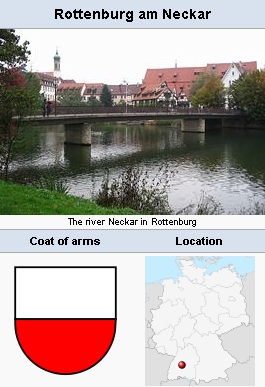Rottenburg am Neckar (Baden-Württemberg, Germany)

Rottenburg am Neckar, a town (population of 9,500 in 1959, 42,761 in 2006) on the Neckar (coordinates: 48° 28′ 38″ N, 8° 56′ 4″ E), between Horb and Tübingen, Baden-Württemberg, Germany, until 1806 the seat of the Austrian rule of Hohenberg, now the seat of a Catholic bishop and of a Catholic seminary.
In the spring of 1526 Wilhelm Reublin, a native of this town, appeared here with his wife and stayed in the home of Jörg Schuhmacher. In both Rottenburg and Horb he won and baptized a large number of followers. He called his friend Michael Sattler to Horb. In February 1527, when the authorities became aware of the Anabaptists, Reublin fled to Reutlingen, while Sattler with his wife and his fellows was arrested and taken to Binsdorf (see Horb). On 17 May a court session was held in Rottenburg, and on 21 May the inhumane execution of Sattler was carried out. On the next day his wife was drowned in the Neckar. Of his companions some were put to death and some exiled. In 1528 eleven persons were sentenced, some to death and some to exile. In 1529, Anabaptists who had lain in prison 157 days were driven from the town with rods after the executioner had burned an image of the devil on their foreheads.
Thus Anabaptism was exterminated from Rottenburg. For some time longer Lutheranism tried to maintain itself, but finally the Austrian audiorities were successful in keeping it a Catholic town.
On 16 August 1957, the Sixth Mennonite World Conference dedicated a memorial plaque to Michael Sattler in the Lutheran parish church in Rottenburg, at which time a special memorial service was held.
Bibliography
Beschreibung des Oberamts Rottenburg I. Stuttgart, 1899: 379-412.
Bossert, Gustav. Blätter für württembergische Kirchengeschichte: I. 1866: 25 f.; II 1887: 1-89; III 1888: 4-65; new series VIII 1904: 148 ff; XVI 1912: 148 ff.
Bossert, Gustav. "Das Blutgericht von Rottenburg." Christliche Welt (Leipzig, 1891): 22 ff; reprint (Barmen, 1928).
Hege, Christian and Christian Neff. Mennonitisches Lexikon, 4 vols. Frankfurt & Weierhof: Hege; Karlsruhe: Schneider, 1913-1967: v. III, 554 f.
Maps
Map:Rottenburg am Neckar, Baden-Württemberg
| Author(s) | Gustav Bossert, Jr. |
|---|---|
| Ernst Crous | |
| Date Published | 1959 |
Cite This Article
MLA style
Bossert, Jr., Gustav and Ernst Crous. "Rottenburg am Neckar (Baden-Württemberg, Germany)." Global Anabaptist Mennonite Encyclopedia Online. 1959. Web. 18 Apr 2024. https://gameo.org/index.php?title=Rottenburg_am_Neckar_(Baden-W%C3%BCrttemberg,_Germany)&oldid=146196.
APA style
Bossert, Jr., Gustav and Ernst Crous. (1959). Rottenburg am Neckar (Baden-Württemberg, Germany). Global Anabaptist Mennonite Encyclopedia Online. Retrieved 18 April 2024, from https://gameo.org/index.php?title=Rottenburg_am_Neckar_(Baden-W%C3%BCrttemberg,_Germany)&oldid=146196.
Adapted by permission of Herald Press, Harrisonburg, Virginia, from Mennonite Encyclopedia, Vol. 4, p. 371. All rights reserved.
©1996-2024 by the Global Anabaptist Mennonite Encyclopedia Online. All rights reserved.
